Why does bitcoin only rise when the US government reopens?
After being suspended for 36 days, has the TGA drained global liquidity?
The U.S. government shutdown has officially entered a record-breaking 36th day.
Over the past two days, global financial markets have plunged. Nasdaq, bitcoin, tech stocks, the Nikkei index, and even safe-haven assets like U.S. Treasuries and gold have not been spared.
Panic is spreading throughout the market, while politicians in Washington continue to argue endlessly over the budget. Is there a connection between the U.S. government shutdown and the global financial market downturn? The answer is beginning to emerge.
This is not an ordinary market correction, but a liquidity crisis triggered by the government shutdown. When fiscal spending is frozen and hundreds of billions of dollars are locked in the Treasury's account, unable to flow into the market, the financial system's lifeblood is being cut off.
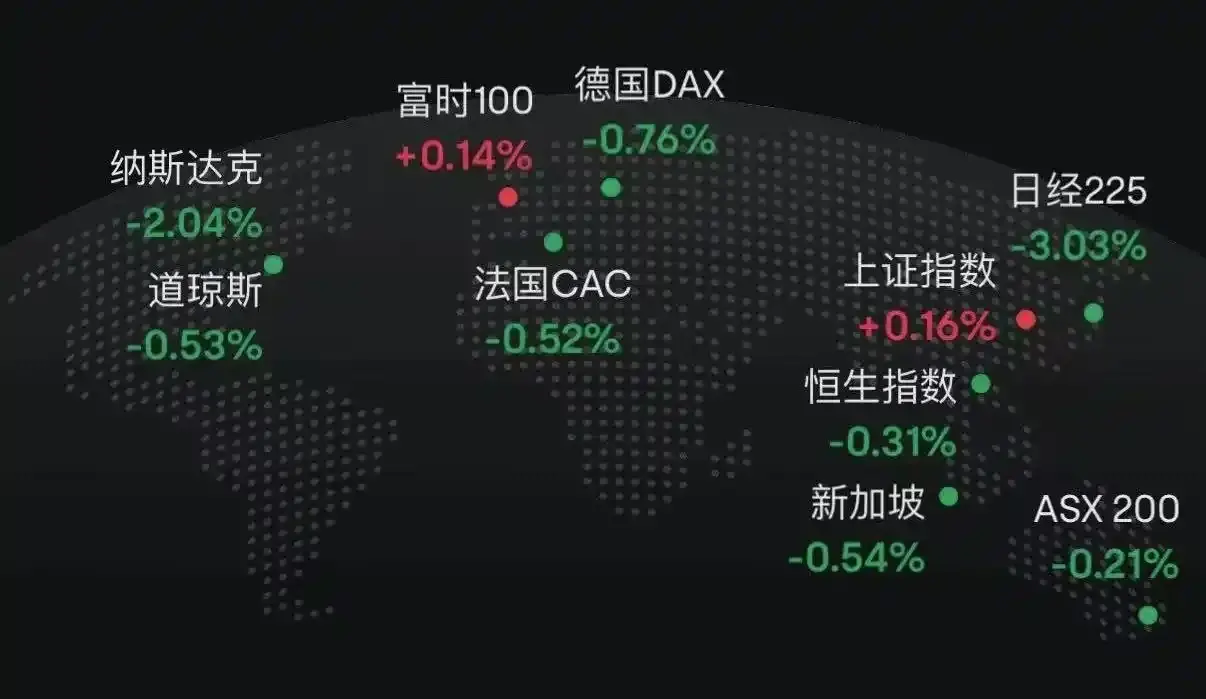
The Real Culprit Behind the Drop: The Treasury's "Black Hole"
The U.S. Treasury General Account (TGA) can be understood as the central checking account the U.S. government holds at the Federal Reserve. All federal revenues, whether from taxes or bond issuance, are deposited into this account.
All government expenditures, from paying civil servants to defense spending, are also disbursed from this account.
Under normal circumstances, the TGA acts as a transit station for funds, maintaining a dynamic balance. The Treasury collects money and then quickly spends it, with funds flowing into the private financial system, becoming bank reserves and providing liquidity to the market.
The government shutdown has broken this cycle. The Treasury continues to collect money through taxes and bond issuance, and the TGA balance keeps growing. But since Congress has not approved the budget, most government departments are closed, and the Treasury cannot spend as planned. The TGA has become a financial black hole with only inflows and no outflows.
Since the shutdown began on October 10, 2025, the TGA balance has swelled from about $800 billion to over $1 trillion by October 30. In just 20 days, more than $200 billion has been withdrawn from the market and locked away in the Federal Reserve's vault.
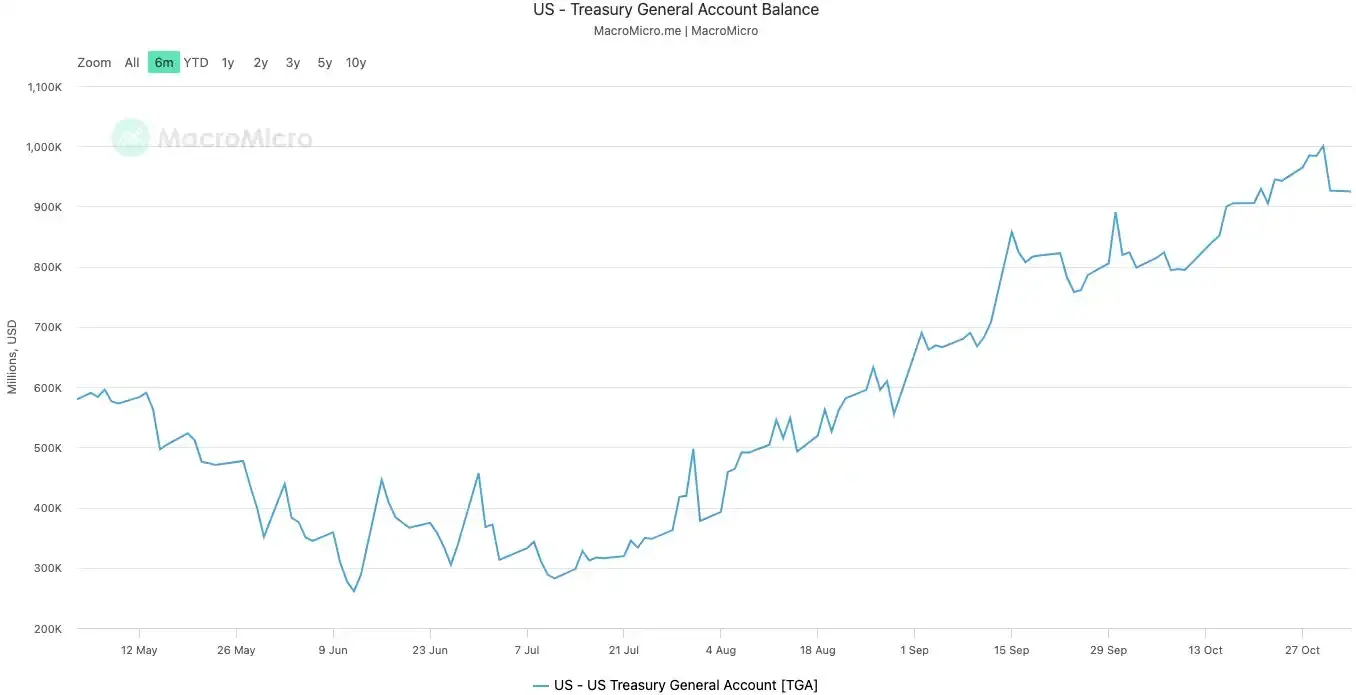
U.S. government TGA balance | Source: MicroMacro
Some analyses point out that the government shutdown has withdrawn nearly $700 billion in liquidity from the market within a month. This effect is comparable to several rounds of Federal Reserve rate hikes or accelerated quantitative tightening.
When bank reserves are massively siphoned off by the TGA, banks' ability and willingness to lend drop sharply, and the cost of funds in the market soars.
The assets most sensitive to liquidity are always the first to feel the chill. The crypto market plunged on October 11, the day after the shutdown, with liquidations approaching $20 billion. This week, tech stocks also wobbled, with the Nasdaq index falling 1.7% on Tuesday, and Meta and Microsoft tumbling after earnings reports.
The decline in global financial markets is the most direct manifestation of this invisible tightening.
The System Has a "Fever"
The TGA is the "cause" of the liquidity crisis, while the soaring overnight repo rate is the most direct "fever" symptom of the financial system.
The overnight repo market is where banks lend short-term funds to each other, acting as the capillaries of the entire financial system. Its rate is the truest indicator of the tightness of interbank liquidity. When liquidity is ample, banks can easily borrow from each other and rates are stable. But when liquidity is drained, banks start to run short and are willing to pay more to borrow overnight.
Two key indicators clearly show how severe this fever is:
The first is SOFR (Secured Overnight Financing Rate). On October 31, SOFR soared to 4.22%, the largest daily increase in a year.
This not only exceeds the Federal Reserve's upper limit for the federal funds rate of 4.00%, but is also 32 basis points higher than the Fed's effective funds rate, reaching the highest level since the market crisis in March 2020. The actual borrowing cost in the interbank market has spun out of control, far exceeding the central bank's policy rate.

SOFR Index | Source: Federal Reserve Bank of New York
The second, even more astonishing indicator, is the usage of the Fed's SRF (Standing Repo Facility). The SRF is an emergency liquidity tool provided by the Fed, allowing banks to pledge high-grade bonds in exchange for cash when they can't borrow in the market.
On October 31, SRF usage soared to $50.35 billion, the highest since the pandemic crisis in March 2020. The banking system has fallen into a severe dollar shortage, forced to knock on the Fed's last-resort window.
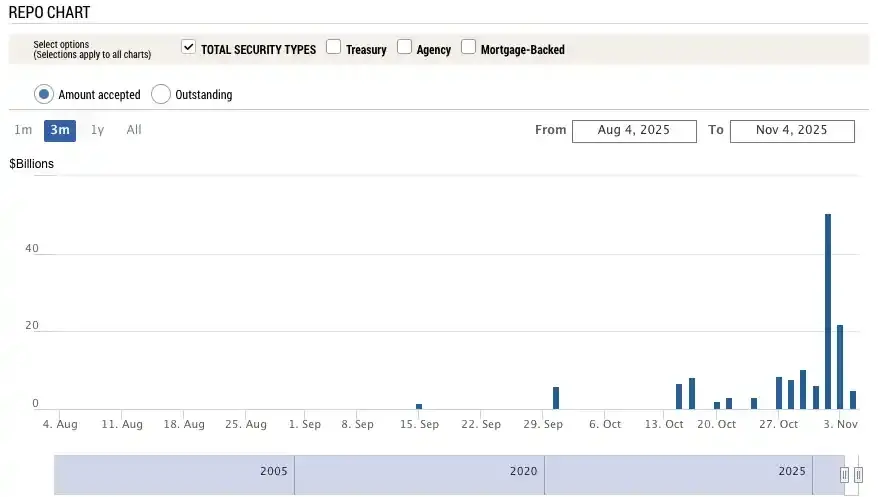
SRF Usage | Source: Federal Reserve Bank of New York
The financial system's fever is transmitting pressure to the weak links of the real economy, triggering long-hidden debt landmines. The two most dangerous areas right now are commercial real estate and auto loans.
According to research firm Trepp, the default rate for U.S. office CMBS (Commercial Mortgage-Backed Securities) reached 11.8% in October 2025, not only a record high but even surpassing the 10.3% peak during the 2008 financial crisis. In just three years, this figure has surged nearly tenfold from 1.8%.
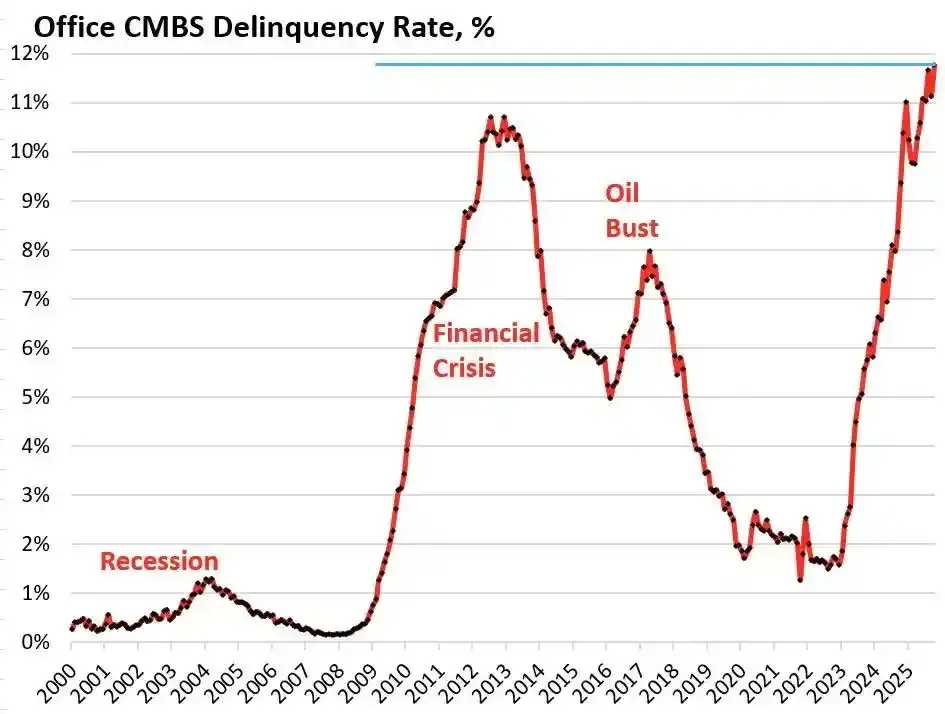
U.S. Office CMBS Default Rate | Source: Wolf Street
Bravern Office Commons in Bellevue, Washington, is a typical case. This office building, once fully leased by Microsoft, was valued at $605 million in 2020. Now, with Microsoft's departure, its value has plunged 56% to $268 million and has entered default proceedings.
This most severe commercial real estate crisis since 2008 is spreading systemic risk throughout the financial system via regional banks, real estate investment trusts (REITs), and pension funds.
On the consumer side, alarms are also sounding for auto loans. New car prices have soared to an average of over $50,000, subprime borrowers face loan rates as high as 18-20%, and a wave of defaults is coming. As of September 2025, the subprime auto loan default rate is close to 10%, and the overall auto loan delinquency rate has increased by more than 50% over the past 15 years.
Under the pressure of high interest rates and high inflation, the financial situation of lower-income U.S. consumers is rapidly deteriorating.
From the TGA's invisible tightening, to the system-wide fever in overnight rates, to the debt blowups in commercial real estate and auto loans, a clear crisis transmission chain has emerged. The fuse unexpectedly lit by Washington's political deadlock is igniting structural weaknesses that have long existed within the U.S. economy.
What Do Traders Think About the Market Outlook?
In the face of this crisis, the market is deeply divided. Traders stand at a crossroads, fiercely debating the future direction.
The pessimists, represented by Mott Capital Management, believe the market is facing a liquidity shock comparable to late 2018. Bank reserves have fallen to dangerous levels, very similar to the situation during the Fed's balance sheet reduction that triggered market turmoil in 2018. As long as the government shutdown continues and the TGA keeps sucking up liquidity, the market's pain will not end. The only hope lies in the Treasury's Quarterly Refunding Announcement (QRA) on November 2. If the Treasury decides to lower the TGA's target balance, it could release over $150 billion in liquidity to the market. But if the Treasury maintains or even raises the target, the market's winter will become even longer.
Famed macro analyst Raoul Pal, representing the optimists, has proposed an intriguing "window of pain" theory. He acknowledges that the market is currently in a painful window of liquidity tightening, but firmly believes that a flood of liquidity will follow. Over the next 12 months, the U.S. government will need to roll over as much as $10 trillion in debt, forcing it to ensure market stability and liquidity.
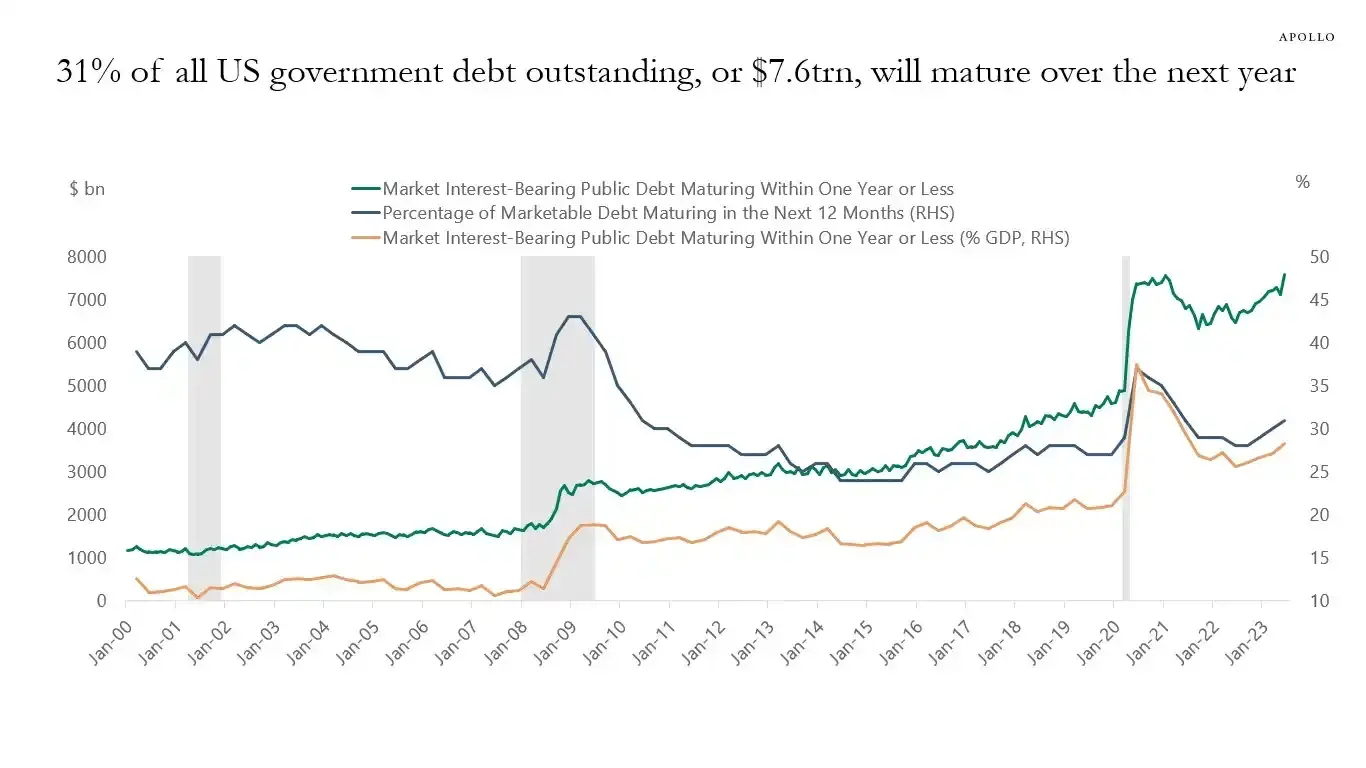
31% of U.S. government debt (about $7 trillion) will mature within the next year, and with new debt issuance, the total could reach $10 trillion | Source: Apollo Academy
Once the government shutdown ends, the pent-up hundreds of billions in fiscal spending will flood into the market, the Fed's quantitative tightening (QT) will technically end, and may even reverse.
To prepare for the 2026 midterm elections, the U.S. government will spare no effort to stimulate the economy, including rate cuts, relaxing bank regulations, and passing cryptocurrency legislation. With China and Japan also continuing to expand liquidity, the world will usher in a new round of monetary easing. The current correction is just a shakeout in a bull market, and the real strategy should be to buy the dip.
Mainstream institutions such as Goldman Sachs and Citi take a relatively neutral view. They generally expect the government shutdown to end within the next one to two weeks. Once the deadlock is broken, the huge cash locked in the TGA will be quickly released, easing market liquidity pressures. But the long-term direction still depends on the Treasury's QRA announcement and subsequent Fed policy.
History seems to repeat itself. Whether it was the balance sheet reduction panic in 2018 or the repo crisis in September 2019, both ultimately ended with the Fed capitulating and injecting liquidity again. This time, facing the dual pressures of political deadlock and economic risk, policymakers seem to have arrived at a familiar crossroads once more.
In the short term, the fate of the market hangs on the whims of Washington politicians. But in the long run, the global economy seems to be deeply trapped in a cycle of debt, monetary easing, and bubbles, unable to extricate itself.
This crisis, unexpectedly triggered by the government shutdown, may be just the prelude to the next, even larger wave of liquidity frenzy.
Disclaimer: The content of this article solely reflects the author's opinion and does not represent the platform in any capacity. This article is not intended to serve as a reference for making investment decisions.
You may also like
Latest! Polkadot updates its 2025 roadmap, with several core products set to launch soon!

"I'm not good at management" — Gavin Wood's choice is also Polkadot's opportunity!

Breaking! Polkadot's PolkaVM smart contract has officially launched on Kusama!

Near Protocol (NEAR) Holds Key Support — Could This Pattern Trigger an Rebound?

